Effect of Nano-Magnesium Oxide on the Expansion Performance and Hydration Process of Cement-Based Materials
Abstract
:1. Introduction
2. Test Materials and Methods
2.1. Test Materials
2.2. Test Methods
2.2.1. Consistency and Fluidity of Cement Paste
2.2.2. Expansion Performance Tests of Cement Paste
2.2.3. Strength Tests of Mortar
2.2.4. Stability Tests of Cement Paste
2.2.5. X-ray Diffraction (XRD) Tests
2.2.6. Scanning Electronic Microscopy (SEM) Tests
3. Test Results and Discussion
3.1. Effect of Nano-MgO Content on the Consistency and Fluidity of Cement Paste
3.2. Effect of Nano-MgO Content on Expansion Performance of Cement Paste
3.3. Effect of Nano-MgO Content on Mortar Strength
3.4. Relationship between Stability of Cement Paste and Nano-MgO Mixed Content
3.5. Analysis of XRD Test Results
3.6. SEM Analysis
4. Conclusions
Author Contributions
Funding
Institutional Review Board Statement
Informed Consent Statement
Data Availability Statement
Acknowledgments
Conflicts of Interest
References
- Hou, P.; Cai, Y.; Zhou, Z.; Li, W.; Shah, S.P.; Cheng, X.; Zhang, X.; Ye, Z.; Zhang, L. Effects of the hydration reactivity of ultrafine magnesium oxide on cement-based materials. Mag. Concr. Res. 2017, 69, 1135–1145. [Google Scholar] [CrossRef]
- Polat, R.; Demirboğa, R.; Karagöl, F. The effect of nano-MgO on the setting time, autogenous shrinkage, microstructure and mechanical properties of high performance cement paste and mortar. Mag. Concr. Res. 2017, 156, 208–218. [Google Scholar] [CrossRef]
- Polat, R.; Demirboğa, R.; Khushefati, W.H. Effects of nano and micro size of CaO and MgO, nano-clay and expanded perlite aggregate on the autogenous shrinkage of mortar. Constr. Build. Mater. 2015, 81, 268–275. [Google Scholar] [CrossRef]
- Sanchez, F.; Sobolev, K. Nanotechnology in concrete—A review. Constr. Build. Mater. 2010, 24, 2060–2071. [Google Scholar] [CrossRef]
- White, A.H. Volume Changes of Portland Cement as Affected by Chemical Composition and Aging; American Society for Testing and Materials: West Conshohocken, PA, USA, 1928. [Google Scholar]
- Cao, Z.; Jinhua, X.U. Dam Construction Technology Using MgO Concrete; China Electric Power Press: Beijing, China, 2003; ISBN 7508314379. [Google Scholar]
- Lou, Z.; Ye, Q.; Chen, H.; Wang, Y.; Shen, J. Hydration of MgO in clinker and its expansion property. J. Chin. Ceram. Soc. 1998, 26, 430–436. [Google Scholar] [CrossRef]
- Ye, Q.; Chen, H.; Wang, Y.; Wang, S.; Lou, Z. Effect of MgO and gypsum content on long-term expansion of low heat Portland slag cement with slight expansion. Cem. Concr. Compos. 2004, 26, 331–337. [Google Scholar] [CrossRef]
- Chen, C.; Fang, K. Study on simulation test method for invariability of concrete with light-burned magnesium oxide. J. Hydroelectr. Eng. 2012, 31, 241–244. [Google Scholar]
- Liu, Y.; Shi, T.; Zhao, Y.; Gu, Y.; Zhao, Z.; Chen, J.; Zheng, B.; Shi, S. Autogenous shrinkage and crack resistance of carbon nanotubes reinforced cement-based materials. Int. J. Concr. Struct. Mater. 2020, 14, 43. [Google Scholar] [CrossRef]
- Shi, T.; Li, Z.; Guo, J.; Gong, H.; Gu, C. Research progress on CNTs/CNFs-modified cement-based composites—A review. Constr. Build. Mater. 2019, 202, 290–307. [Google Scholar] [CrossRef]
- Shi, T.; Zexin, L.; Shanshan, L. Autogenous shrinkage and crack resistance of carbon nanotubes reinforced cement based composites. Acta Mater. Compos. Sin. 2019, 36, 1528–1535. [Google Scholar] [CrossRef]
- Zhao, Y.; Liu, Y.; Shi, T.; Gu, Y.; Zheng, B.; Zhang, K.; Xu, J.; Fu, Y.; Shi, S. Study of mechanical properties and early-stage deformation properties of graphene-modified cement-based materials. Constr. Build. Mater. 2020, 257, 119498. [Google Scholar] [CrossRef]
- Moradpour, R.; Taheri-Nassaj, E.; Parhizkar, T.; Ghodsian, M. The effects of nanoscale expansive agents on the mechanical properties of non-shrink cement-based composites: The influence of nano-MgO addition. Compos. Part B Eng. 2013, 55, 193–202. [Google Scholar] [CrossRef]
- Ye, Q.; Yu, K.; Zhang, Z. Expansion of ordinary Portland cement paste varied with nano-MgO. Constr. Build. Mater. 2015, 78, 189–193. [Google Scholar] [CrossRef]
- Qureshi, T.S.; Al-Tabbaa, A. Self-healing of drying shrinkage cracks in cement-based materials incorporating reactive MgO. Smart Mater. Struct. 2016, 25, 084004. [Google Scholar] [CrossRef]
- Qureshi, T.; Kanellopoulos, A.; Al-Tabbaa, A. Autogenous self-healing of cement with expansive minerals-I: Impact in early age crack healing. Constr. Build. Mater. 2018, 192, 768–784. [Google Scholar] [CrossRef] [Green Version]
- Litina, C.; Bumanis, G.; Anglani, G.; Dudek, M.; Maddalena, R.; Amenta, M.; Papaioannou, S.; Pérez, G.; Calvo, J.G.; Asensio, E.; et al. Evaluation of methodologies for assessing self-healing performance of concrete with mineral expansive agents: An interlaboratory study. Materials 2021, 14, 2024. [Google Scholar] [CrossRef]
- Wang, X. Investigations of Nano-Materials Modified Cement Slurry(Stone) Structure and Properties. Master’s Thesis, China University of Petroleum, Beijing, China, 2016; pp. 37–38. [Google Scholar]
- Ding, W. Study on the Properties of Cement Paste and Mortar with MgO Expansive Admixture. Master’s Thesis, Southwest University of Science and Technology, Mianyang, China, 2016; pp. 36–37. [Google Scholar]
- Mo, L.; Deng, M. Thermal behavior of cement matrix with high-volume mineral admixtures at early hydration age. Cem. Concr. Res. 2006, 36, 1992–1998. [Google Scholar] [CrossRef]
- Mo, L.; Min, D.; Tang, M. Effects of calcination condition on expansion property of MgO-type expansive agent used in cement-based materials. Cem. Concr. Res. 2010, 40, 437–446. [Google Scholar] [CrossRef]
- Zhang, X. Microscopic Characterization and Early age Performance of MgO and Nano-MgO High Performance Concrete. Master’s Thesis, Shandong University, Jinan, China, 2019; pp. 33–34. [Google Scholar]
- Ding, W.; Tan, K.; Liu, L.; Tang, K.; Zhao, C. Influence research of light-burned magnesia on autogenous shrinkage and pore structure of steam-cured cement paste. China Concr. Cem. Prod. 2016, 5, 21–26. (In Chinese) [Google Scholar] [CrossRef]
- Ye, Q.; Yu, S.; Zhang, Z.; Zhang, Q.; Shi, T. Effect of Nano-MgO on the expansion and strength of hardened cement paste. J. Build. Mater. 2017, 20, 765–769. (In Chinese) [Google Scholar] [CrossRef]
- Zhou, L.; Wang, Y.; Zhang, G.; Zhang, F. Research progress in the effect of nano-MgO on the properties of cement-based materials. China Concr. Cem. Prod. 2019, 5, 13–18. (In Chinese) [Google Scholar] [CrossRef]
- Chatterji, S. Mechanism of expansion of concrete due to the presence of dead-burnt CaO and MgO. Cem. Concr. Res. 1995, 25, 51–56. [Google Scholar] [CrossRef]
- Li, C.; Li, X.; Chen, X. Influence of pressure-braise system on the pressure-braise expansion ratio of concrete and cement mortar mixed with MgO. Adv. Sci. Technol. Water Resour. 2009, 29, 24–28. [Google Scholar] [CrossRef]
- Sherir, M.A.; Hossain, K.M.; Lachemi, M. Self-healing and expansion characteristics of cementitious composites with high volume fly ash and MgO-type expansive agent. Constr. Build. Mater. 2016, 127, 80–92. [Google Scholar] [CrossRef]
- Chen, H. Expansive property and pore structure characterisitics of magnesium oxide slight expansive cement- fly ash binding material. J. Chin. Ceram. Soc. 2005, 33, 516–519. [Google Scholar] [CrossRef]
- Helmuth, R. Reappraisal of the autoclave expansion test. Cem. Concr. Aggreg. 1998, 20, 194–219. [Google Scholar] [CrossRef]
- Ali, M.M.; Mullick, A.K. Volume stabilisation of high MgO cement: Effect of curing conditions and fly ash addition. Cem. Concr. Res. 1998, 28, 1585–1594. [Google Scholar] [CrossRef]
- Gao, P.-W.; Wu, S.-X.; Lu, X.-L.; Deng, M.; Lin, P.-H.; Wu, Z.-R.; Tang, M.-S. Soundness evaluation of concrete with MgO. Constr. Build. Mater. 2007, 21, 132–138. [Google Scholar] [CrossRef]
- Mo, L.; Deng, M.; Wang, A. Effects of MgO-based expansive additive on compensating the shrinkage of cement paste under non-wet curing conditions. Cem. Concr. Compos. 2012, 34, 377–383. [Google Scholar] [CrossRef]
- Yuan, H.; Shi, Y.; Xu, Z.; Lu, C.; Ni, Y.; Lan, X. Effect of nano-MgO on thermal and mechanical properties of aluminate cement composite thermal energy storage materials. Ceram. Int. 2014, 40, 4811–4817. [Google Scholar] [CrossRef]
- Mo, L.; Panesar, D.K. Effects of accelerated carbonation on the microstructure of Portland cement pastes containing reactive MgO. Cem. Concr. Res. 2012, 42, 769–777. [Google Scholar] [CrossRef]
- Mo, L.; Fang, J.; Hou, W.; Ji, X.; Yang, J.; Fan, T.; Wang, H. Synergetic effects of curing temperature and hydration reactivity of MgO expansive agents on their hydration and expansion behaviours in cement pastes. Constr. Build. Mater. 2019, 207, 206–217. [Google Scholar] [CrossRef]
- Cao, F.; Yan, P. Effect of water-binder ratio on hydration degree and expansive characteristics of magnesium oxide expansive agents. J. Chin. Ceram. Soc. 2019, 47, 171–177. (In Chinese) [Google Scholar] [CrossRef]
- Liu, P.; Chen, Z.; Deng, M. Regulating the expansion characteristics of cementitious materials using blended MgO-type expansive agent. Materials 2019, 12, 976. [Google Scholar] [CrossRef] [PubMed] [Green Version]
- José, N.; Ahmed, H.; Miguel, B.; Luís, E.; Jorge, D.B. Magnesia (MgO) production and characterization, and its influence on the performance of cementitious materials: A review. Materials 2020, 13, 4752. [Google Scholar] [CrossRef] [PubMed]
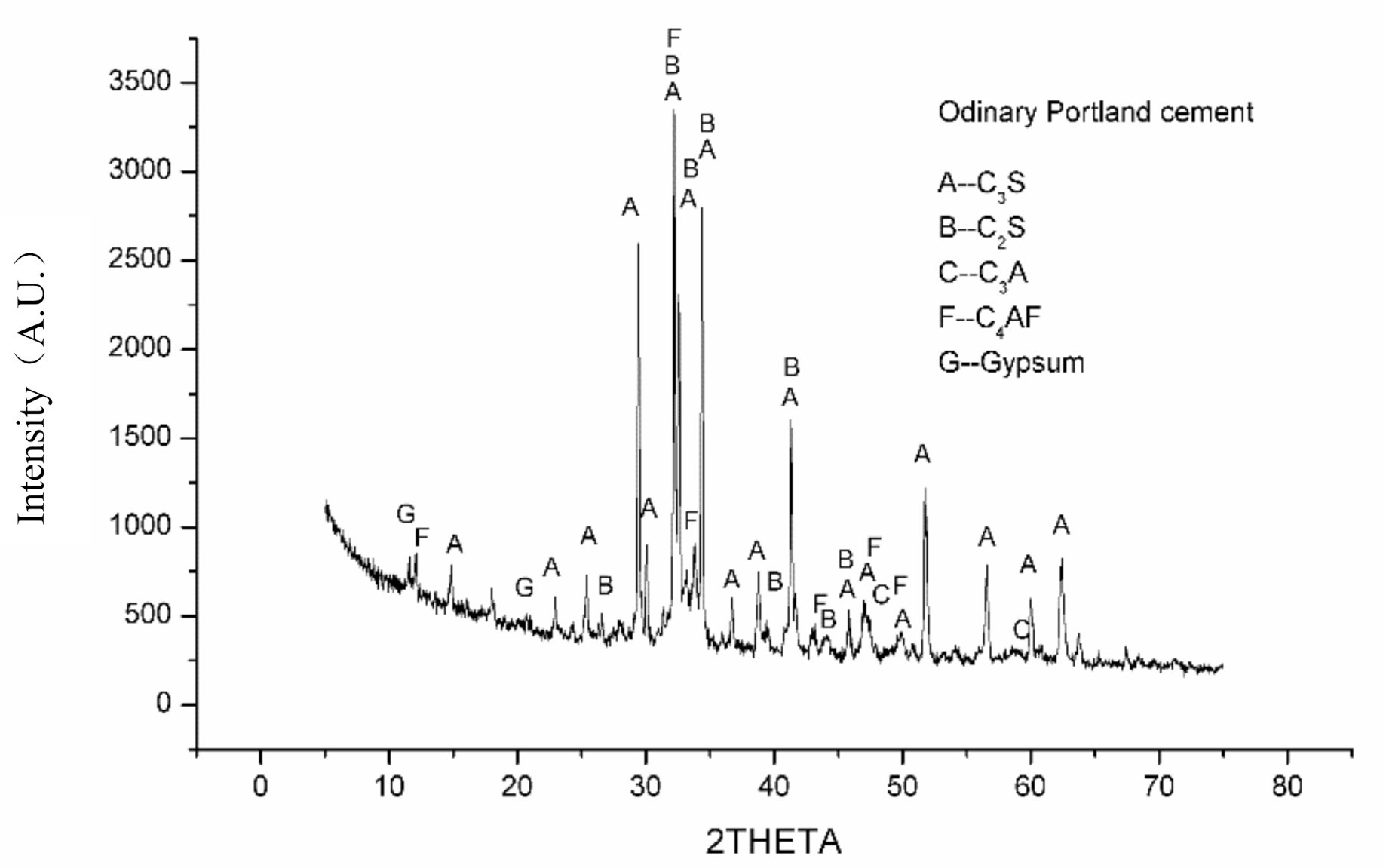
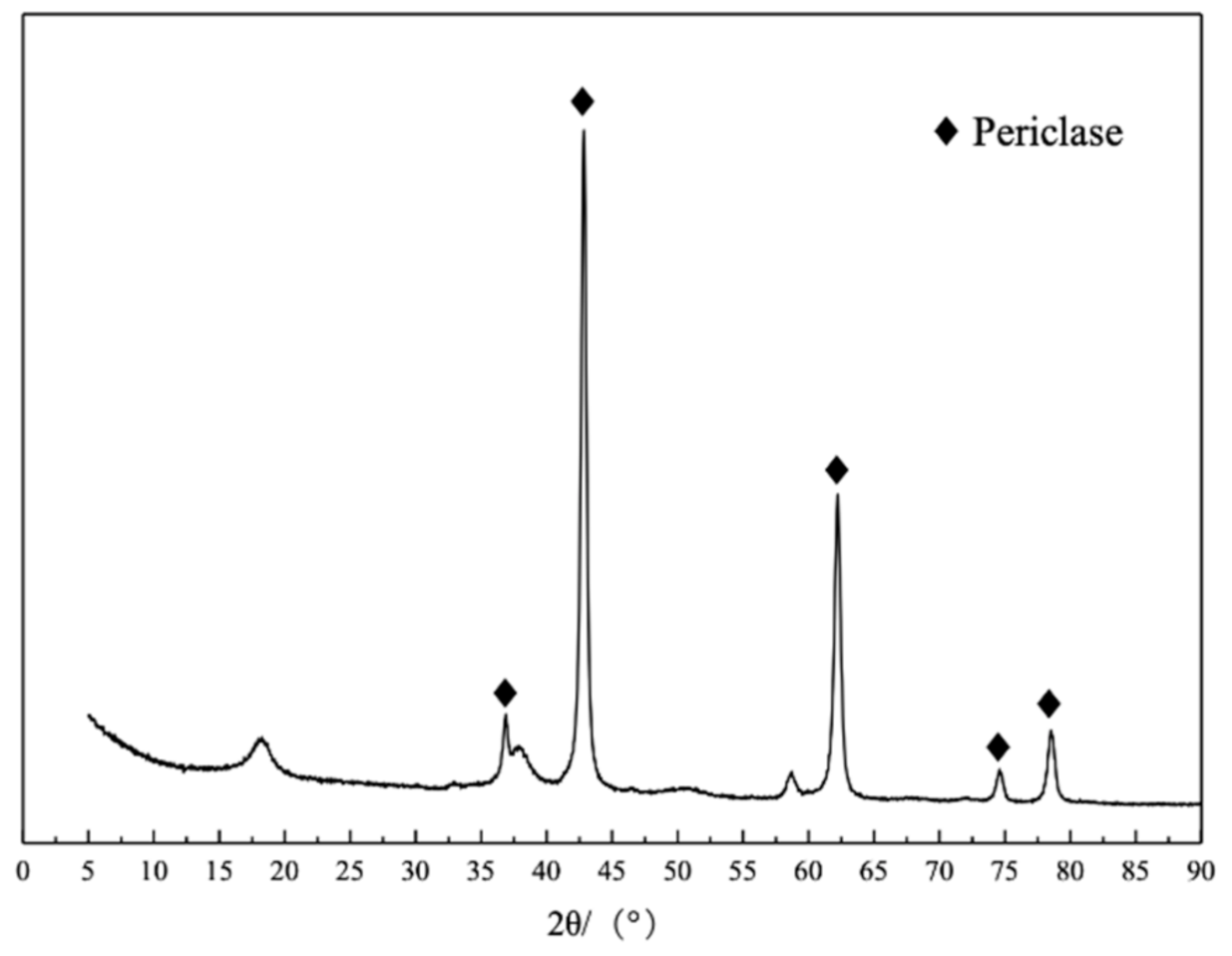
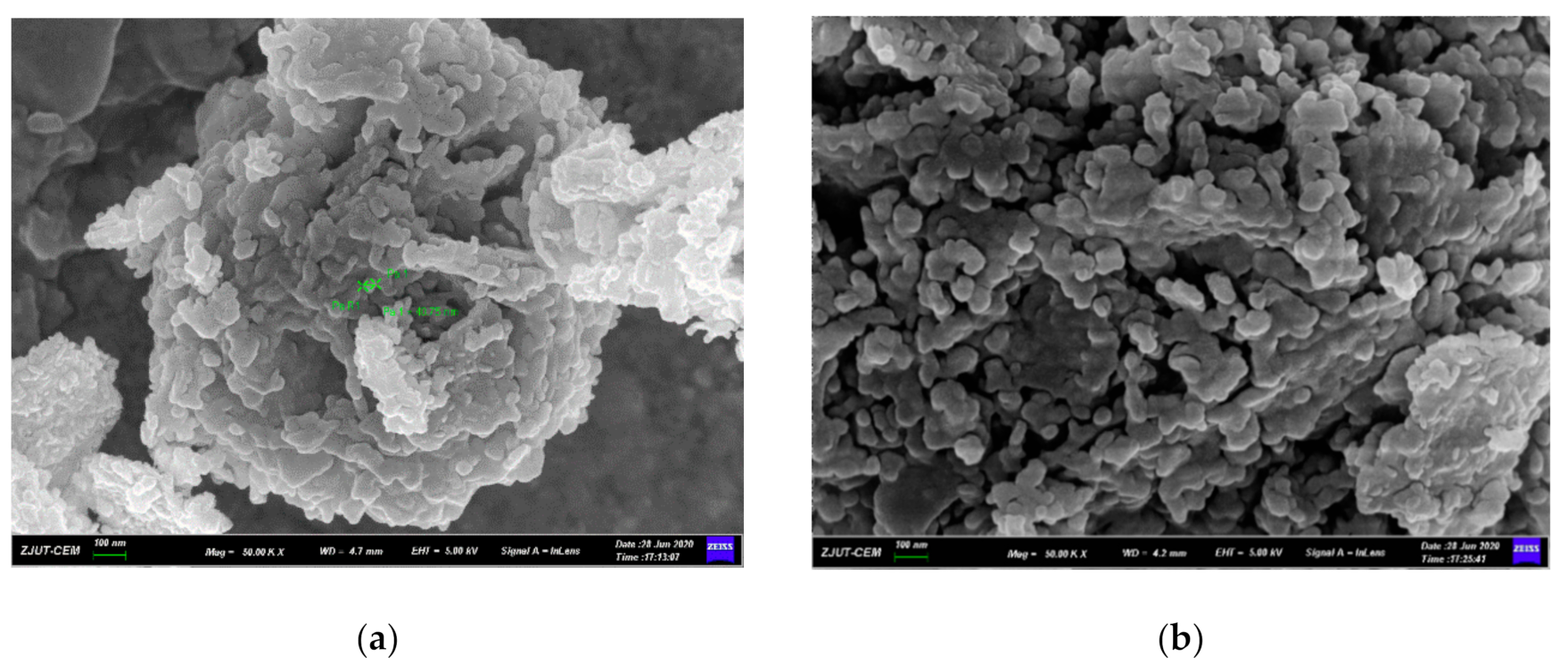
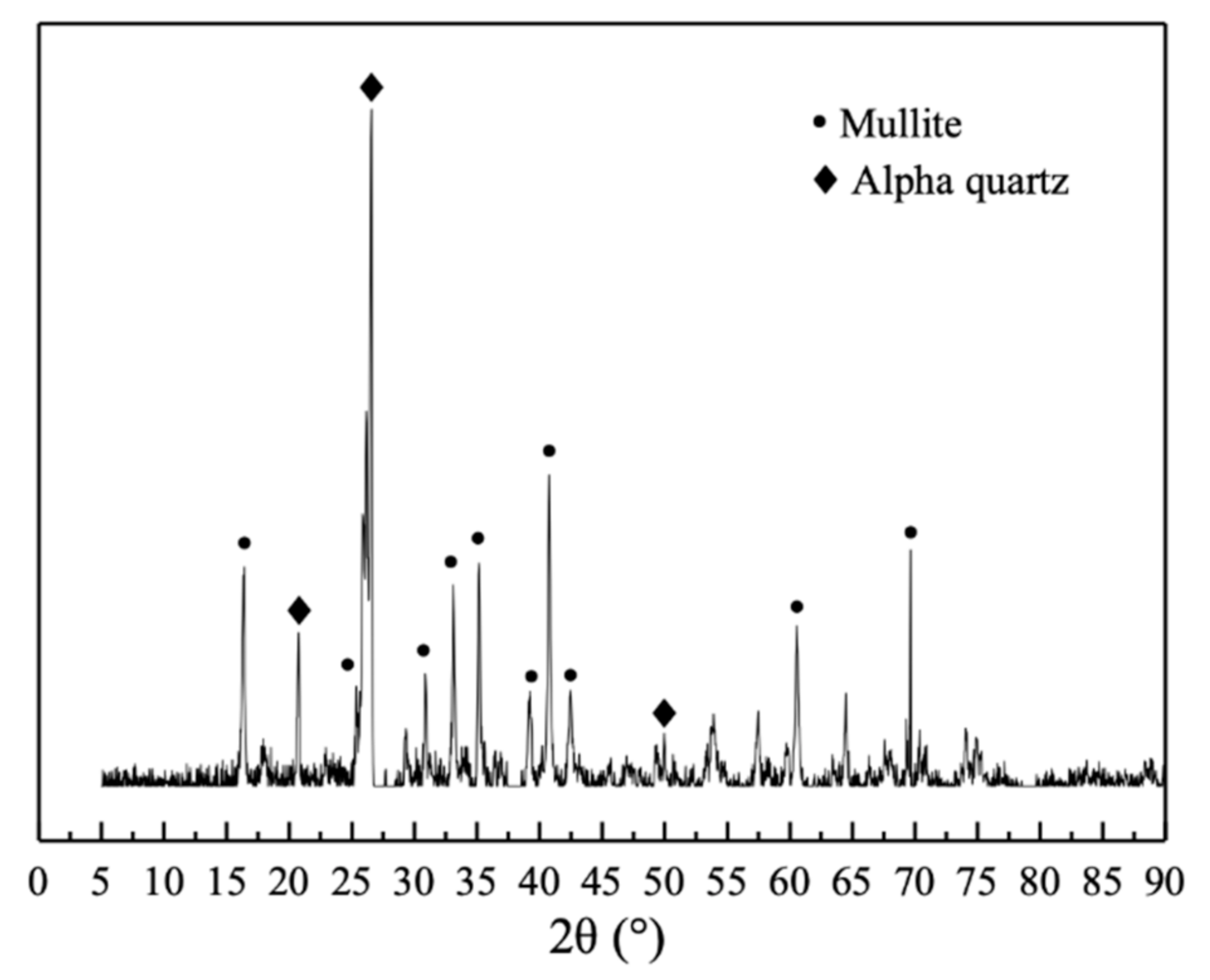
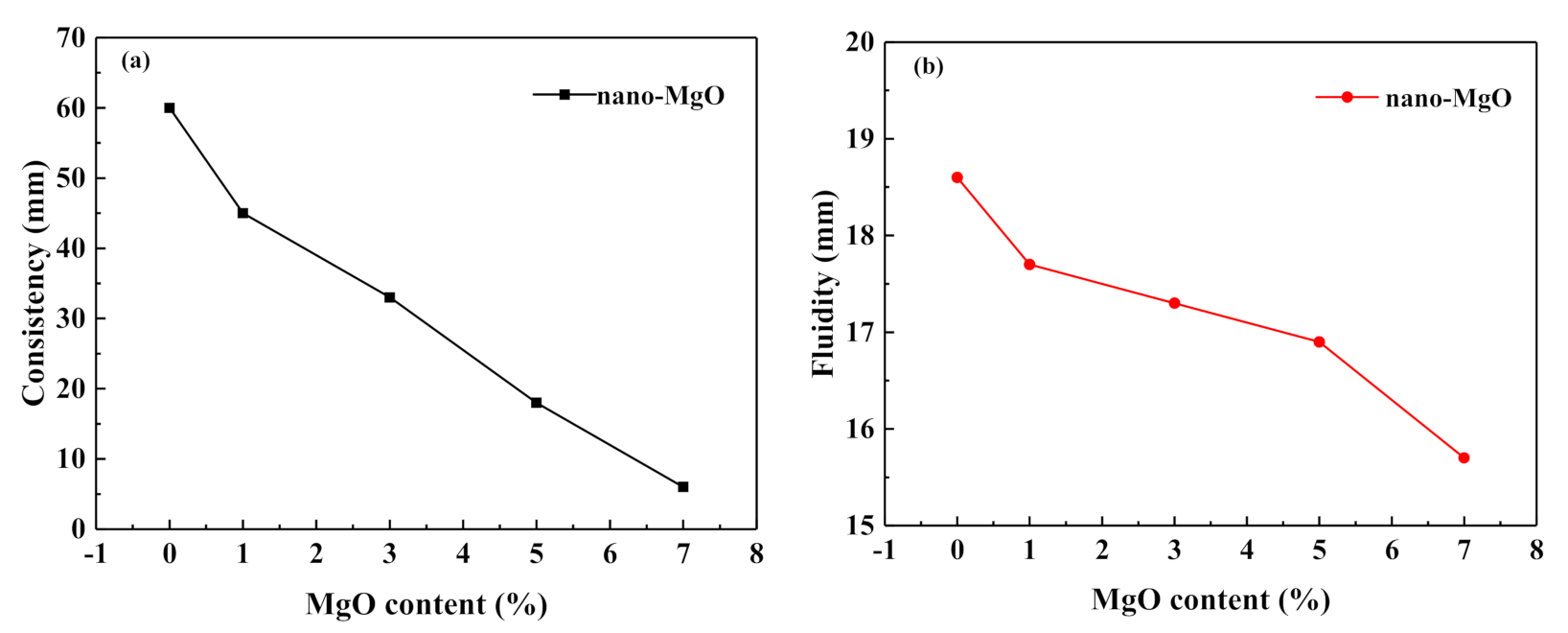
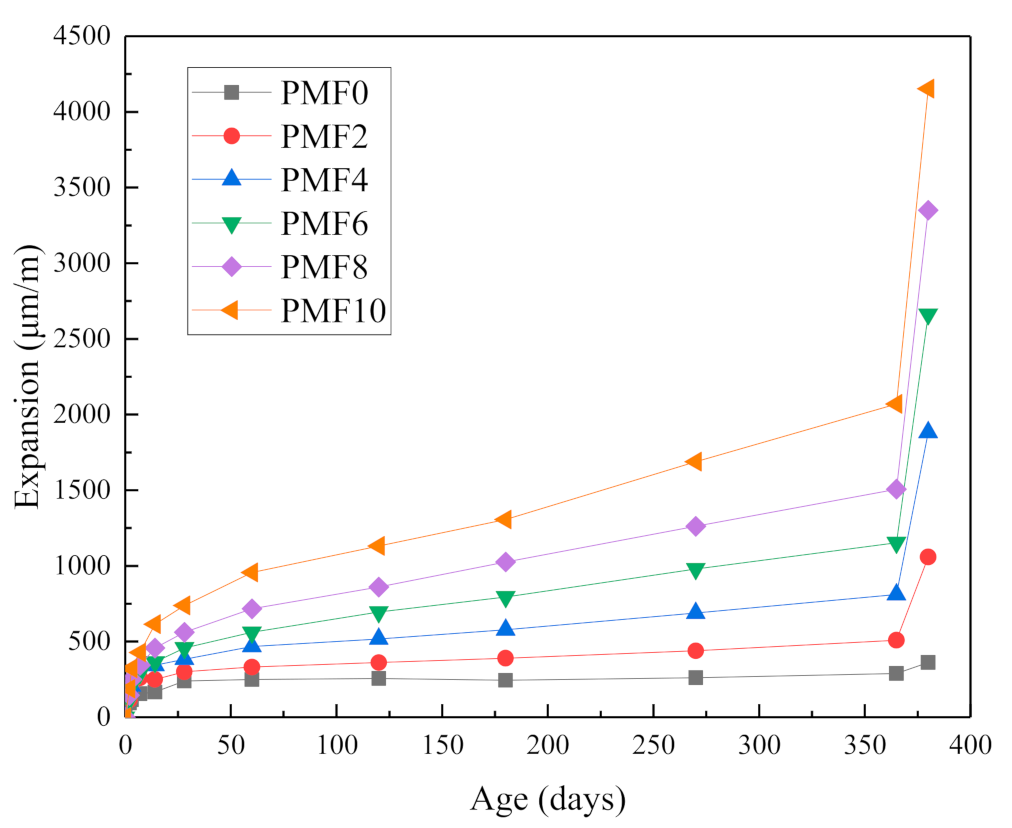

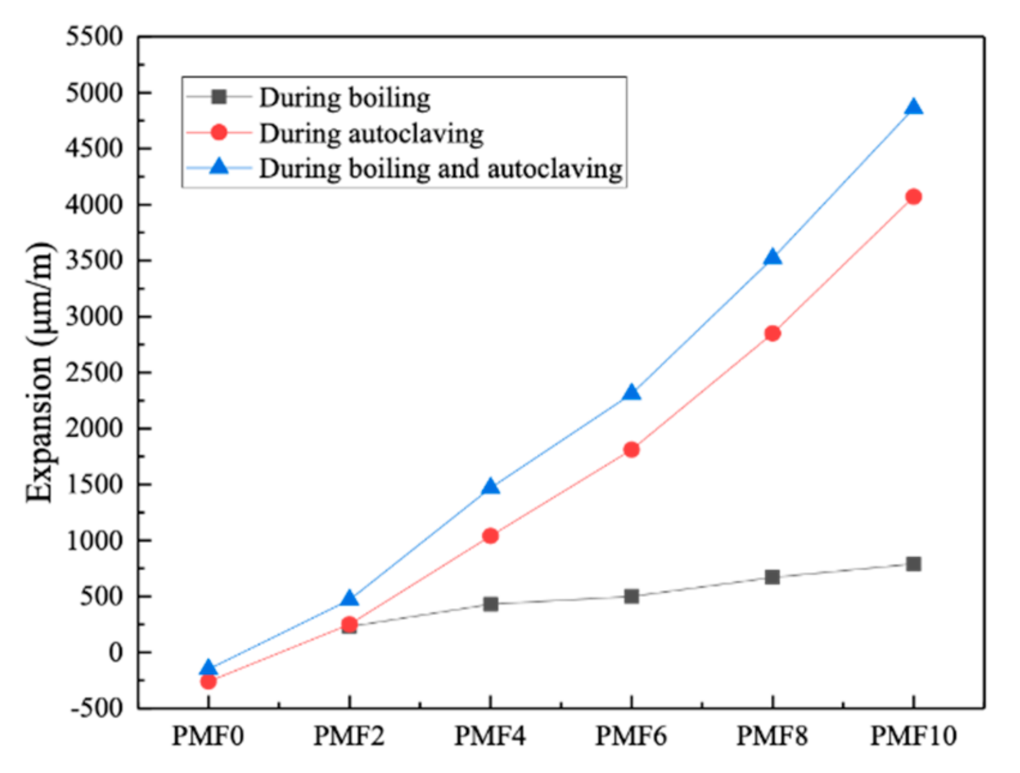
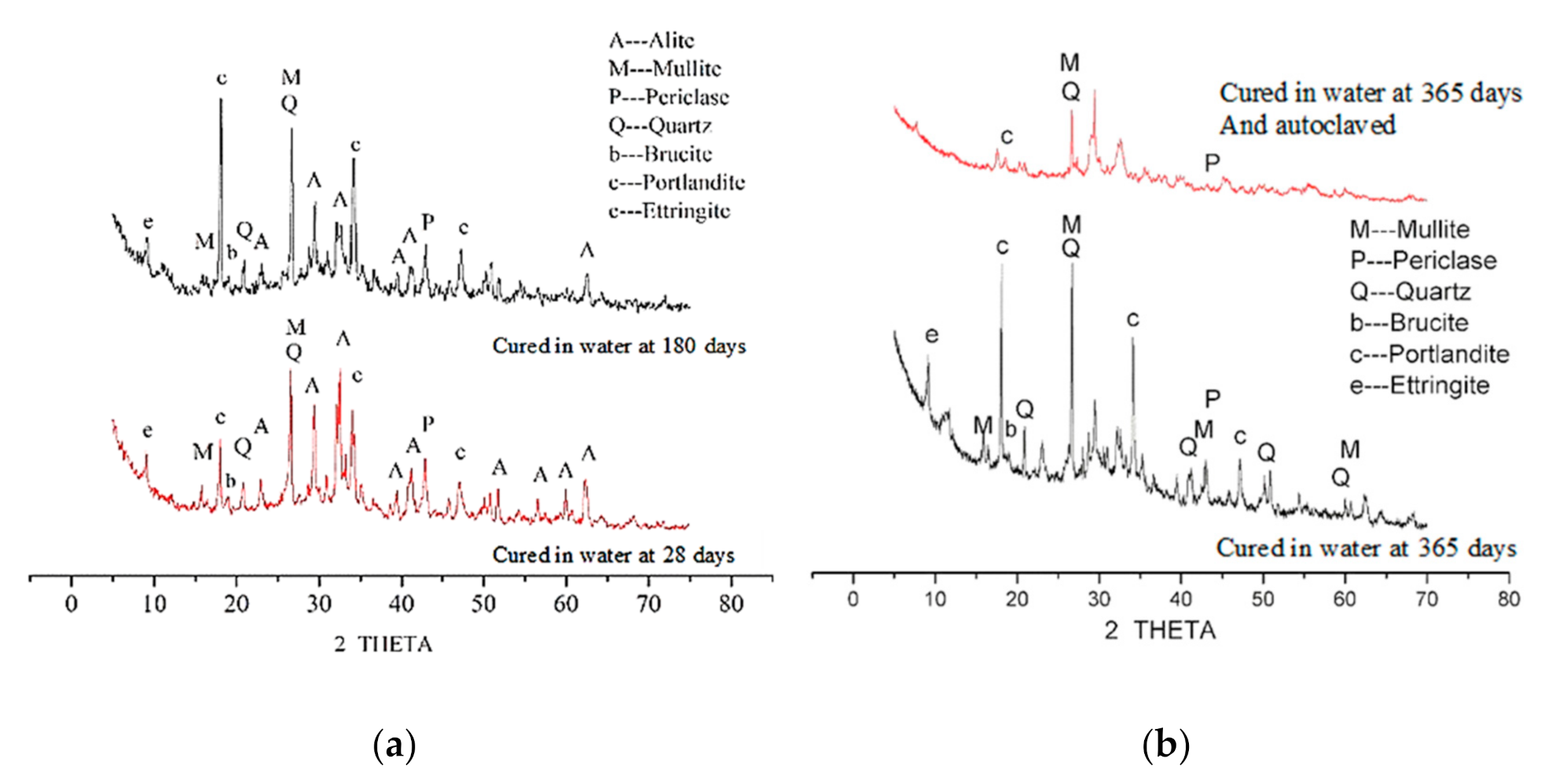

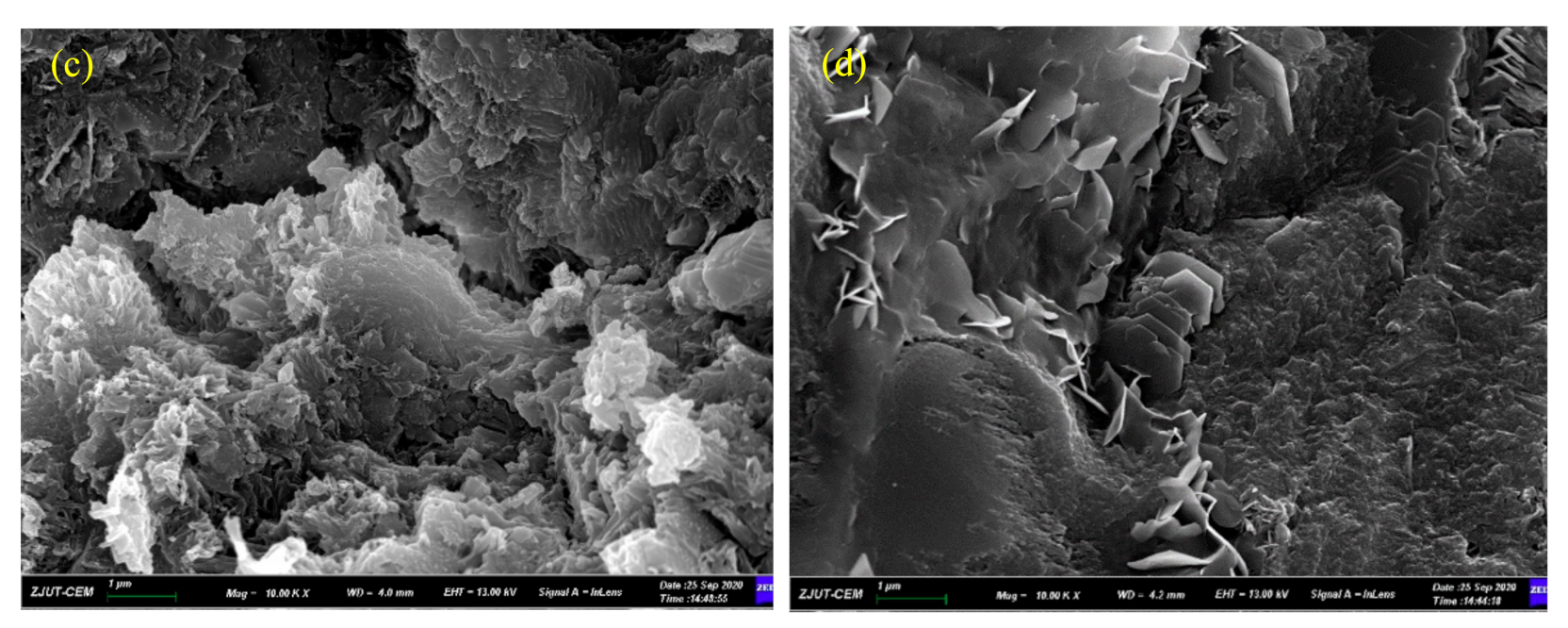
| Material | CaO | SiO2 | Al2O3 | Fe2O3 | MgO | SO3 | K2O | Na2O |
|---|---|---|---|---|---|---|---|---|
| OP cement | 59.53 | 21.63 | 5.85 | 4.90 | 2.02 | 2.80 | 0.65 | 0.23 |
| Fly-ash | 6.06 | 52.34 | 31.74 | 4.26 | 1.66 | 0.40 | 0.95 | 0.81 |
| Nano-MgO | - | - | - | - | 99.90 | - | - | - |
| Paste Code | Doping Proportion of Paste (g) | |||
|---|---|---|---|---|
| OP Cement | Fly-Ash | Nano-MgO | Water | |
| PMF0 | 350 | 150 | 0 | 140 |
| PMF2 | 343 | 147 | 10 | 140 |
| PMF4 | 336 | 144 | 20 | 140 |
| PMF6 | 329 | 141 | 30 | 140 |
| PMF8 | 322 | 138 | 40 | 140 |
| PMF10 | 315 | 135 | 50 | 140 |
| Mortar Code | Doping Proportion of Mortar (g) | ||||
|---|---|---|---|---|---|
| OP Cement | Fly-Ash | Nano-MgO | Water | ISO Sand | |
| MMF0 | 315 | 135 | 0 | 225 | 1350 |
| MMF2 | 309 | 132 | 9 | 225 | 1350 |
| MMF4 | 302 | 130 | 18 | 225 | 1350 |
| MMF6 | 296 | 127 | 27 | 225 | 1350 |
| MMF8 | 290 | 124 | 36 | 225 | 1350 |
| MMF10 | 284 | 121 | 45 | 225 | 1350 |
Publisher’s Note: MDPI stays neutral with regard to jurisdictional claims in published maps and institutional affiliations. |
© 2021 by the authors. Licensee MDPI, Basel, Switzerland. This article is an open access article distributed under the terms and conditions of the Creative Commons Attribution (CC BY) license (https://creativecommons.org/licenses/by/4.0/).
Share and Cite
Ye, Y.; Liu, Y.; Shi, T.; Hu, Z.; Zhong, L.; Wang, H.; Chen, Y. Effect of Nano-Magnesium Oxide on the Expansion Performance and Hydration Process of Cement-Based Materials. Materials 2021, 14, 3766. https://doi.org/10.3390/ma14133766
Ye Y, Liu Y, Shi T, Hu Z, Zhong L, Wang H, Chen Y. Effect of Nano-Magnesium Oxide on the Expansion Performance and Hydration Process of Cement-Based Materials. Materials. 2021; 14(13):3766. https://doi.org/10.3390/ma14133766
Chicago/Turabian StyleYe, Yuxun, Yanming Liu, Tao Shi, Zhuojun Hu, Lei Zhong, Haobo Wang, and Yaohui Chen. 2021. "Effect of Nano-Magnesium Oxide on the Expansion Performance and Hydration Process of Cement-Based Materials" Materials 14, no. 13: 3766. https://doi.org/10.3390/ma14133766
APA StyleYe, Y., Liu, Y., Shi, T., Hu, Z., Zhong, L., Wang, H., & Chen, Y. (2021). Effect of Nano-Magnesium Oxide on the Expansion Performance and Hydration Process of Cement-Based Materials. Materials, 14(13), 3766. https://doi.org/10.3390/ma14133766






